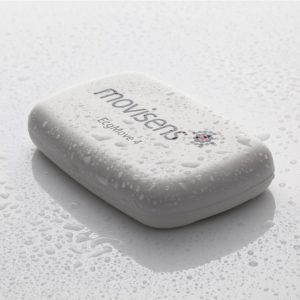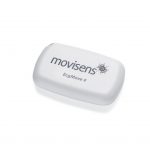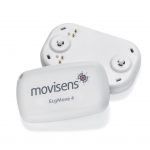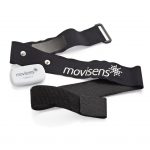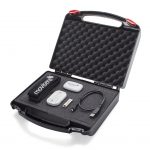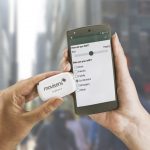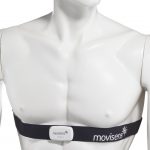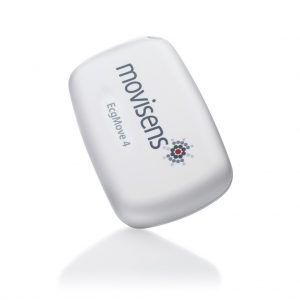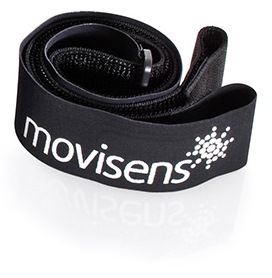EcgMove 4 – ECG and Activity Sensor
ECG- and Activity sensor
New Design - New Features - New Applications
As part of the new sensor generation, the EcgMove 4 activity sensor combines the previous benefits of the proven EcgMove 3 with the 4th generation enhancements, allowing us to address a wide range of researchers' needs, implement their requests, and further enhance the quality of the sensors. Thus, the EcgMove 4 strengthens it's position as the go to device for researchers who care about high quality ECG and Activity data.
The 4th sensor generation offers researchers numerous advantages, including:
The EcgMove 4 follows on from the EcgMove 3 as the most precise sensor for the measurement of ECG combined with physical activity. Capable of long term ambulatory recordings without the inconvenience of cables. Through the parallel recording of the ECG and Activity Signals (ECG, 3D Accelerometer, Gyroscope, Barometric Air Pressure, and Temperature), the EcgMove 4 offers a rich treasure trove of data for the detailed analysis of the functioning of the heart, the autonomic nervous system, and additionally behaviour and activity. Whilst recording the raw data stream, the sensor can also analyze certain parameters live on the sensor and transmit the results via Bluetooth smart interface, e.g. to a smartphone.
The sensor is optimized for use in scientific studies and interactive ambulatory assessment. The new attachment systems offer you great flexibility in use and a high wearing comfort for the study participant, with the choice of adhesive electrodes or our acclaimed dry electrode textile chest belt. This leads to improved compliance, higher data volume and quality, and thus reduces the effort of carrying out a study and reduces costs.
Combined with our Analysis-Software DataAnalyzer allows the simple calculation of parameters such as Heart Frequency, Heart Rate Variability, Activity Class, Steps, Energy Expenditure and Metabolic Equivalent of Task (MET).
Top-Features
- New design with new carrying systems in a waterproof housing
- Advanced data acquisition through integrated gyroscope
- New acceleration sensor with higher resolution
- Attachment detection for automatically starting a measurement
- Live analysis of measurement data
- Improved data transfer via Bluetooth Smart interface
- Combination of ECG- and Activity measurement in a single system
- Exact and validated Energy Expenditure calculations and detection of everyday activities
- Java API for USB (Windows)
- API: Example implementation for Bluetooth Smart (Android)
Applications
- Interactive Ambulatory Assessment
- Mobile long term monitoring of Heart rate and Heart Rate Variability
- Examination of the Autonomic Nervous System
- Behavioural Monitoring
- Psycho-physiological Stress-Monitoring
- Energy Expenditure Calculation and Activity Recognition
- Affective Computing
- Integration in complex systems
Matching products and services

SensorTrigger
movisensXS-Feature pour Évaluation interactive
Echantillonnage de l'expérience basée sur Smartphone
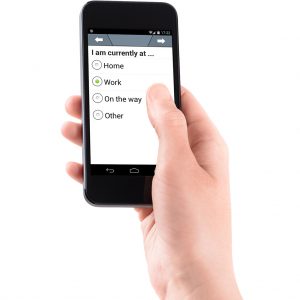
movisensXS
Echantillonnage de l'expérience plateforme
Solution d'échantillonnage de l'expérience basée sur un smartphone
Downloads
| Software |
|
|---|---|
| Documentation |
|
| External Tools |
Technical Data
|
Power supply |
Lithium-Polymer-Battery |
|
Battery voltage |
3,7 V |
|
Number of charging cycles |
300 (with 1 C / 1 C > 80%) |
|
Internal memory |
4 GB |
|
Maximum recording capacity |
2 weeks |
|
Battery run time |
~ 3 days |
|
Recharging time |
~ 1 hour |
|
Size of sensor (W x H x D) |
62,3 mm x 38,6 mm x 11,5 mm |
|
Weight of sensor |
26 g |
|
Protection rate |
Waterproof (IP67) |
|
Internal sensors |
ECG sensor: Resolution: 12 bit, Input range CM = 560 mV, DM = +/-5 mV, 3db bandwidth 1,6 - 33 Hz Output rate: 1024 Hz
3D acceleration sensor: Measurement range: +/- 16 g Output rate: 64 Hz
Rotation rate sensor: Measurement range: +/-2000 dps Output rate: 64 Hz
Pressure sensor: Measurement range: 300 - 1100 hPa Noise: 0,03 hPa Output rate: 8 Hz
Temperature sensor: Output rate: 1 Hz |
|
Live analysis |
Heart Rate bpmBxB NN-List HRV Rmssd HRV is valid Movement Acceleration Step count |
|
Indicators |
LED, 3-color Vibration alarm |
|
User Interfaces |
Marker (tapping) |
|
Interfaces |
Micro-USB, Bluetooth Smart (4.0) |
|
API |
Java API for USB (Windows) Example for Bluetooth Smart (Android) |
|
Wear locations |
Chest |
|
Wearing systems |
Chest Belt, adhesive Electrodes |
|
Environmental conditions |
Temperature: -20 °C to 60 °C 0 °C to 45 °C during charging Atmospheric pressure: 300 to 1200 hPa absolute |
|
Warranty |
1 year |
Literature und Validation
- Brute Force ECG Feature Extraction Applied on Discomfort Detection.
- Self-reported emotion regulation difficulties are associated with mood but not with the biological stress response to thin ideal exposure.
- Energy Expenditure During Incline Walking – Benefits of Integrating a Barometer into Activity Monitors.
- Paranoid Delusions as an Adaptive Response to Social Evaluative Stress?.
- Effectiveness of a smartphone-based worry-reduction training for stress reduction: A randomized-controlled trial.
- An experience sampling study on the nature of the interaction between traumatic experiences, negative affect in everyday life, and threat beliefs.
- Immediate and sustained effects of intermittent exercise on inhibitory control and task-related heart rate variability in adolescents.
- Physiological and cognitive performance of exposure to biophilic indoor environment .
- A Data Compression Hardware Accelerator Enabling Long-Term Biosignal Monitoring Based on Ultra-Low Power IoT Platforms.
- Sport activities in daily routine.
- Physical Activity and Affective Well-Being in Everyday Life Comparing Sport Activities and Daily Physical Activities Regarding Acute and Sustainable Associations.
- Prolonged Non-metabolic Heart Rate Variability Reduction as a Physiological Marker of Psychological Stress in Daily Life.
- Resource Efficient Data Compression Algorithms for Demanding, WSN based Biomedical Applications .
- Mobile Sensors for Multiparametric Monitoring in Epileptic Patients.
- Real-Time Management of Multimodal Streaming Data for Monitoring of Epileptic Patients.
- Does a 20-week aerobic exercise training programme increase our capabilities to buffer real-life stressors? A randomized, controlled trial using ambulatory assessment.
- Integrating biosignals into information systems: A NeuroIS tool for improving emotion regulation.
- A personalized and reconfigurable cyberphysical system to handle multi-parametric data acquisition and analysis for mobile monitoring of epileptic patients.
- Study protocol: psychological and physiological consequences of exposure to mass media in young women-an experimental cross-sectional and longitudinal study and the role of moderators.
- Comparing Objective and Subjective Methods to Support Reflective Learning: an Experiment on the Influence on Affective Aspects.
- Emotions and Emotion Regulation in Economic Decision Making.
- Design and Evaluation of Affective Serious Games for Emotion Regulation Training.
- Komfortgewinn für Passagiere auf Langstreckenflügen durch den Einsatz chronobiologisch angepasster LED-Kabinenbeleuchtung.
- A Biofeedback Game for Training Arousal Regulation during a Stressful Task: The Space Investor.
- Measuring emotional arousal for online applications: Evaluation of ultra-short term heart rate variability measures.
- Enhancing mobile working memory training by using affective feedback..
- Mobile sensor systems for measurement of stress and physical activity in preventive healthcare applications.
- A Serious Game using Physiological Interfaces for Emotion regulation Training in the Context of Financial Decision-Making..
- An approach to automotive ECG measurement validation using a car-integrated test framework.
- Motivation and User Acceptance of Using Physiological Data to Support Individual Reflection.
- Estimation of energy expenditure using accelerometers and activity-based energy models - validation of a new device.
- User Study: Motivation and User Acceptance of Using Physiological Data to Support Individual Reflection..
- From Stress Awareness to Coping Strategies of Medical Staff: Supporting Reflection on Physiological Data.
- Einsatz sensorgestützter Verfahren im Gesundheitswesen: Herausforderungen und Lösungsansätze.
- Sensor Chest Strap Wirelessly Coupled with an e-Diary for Ambulatory Assessment of Psycho-Physiological Data.
- Heart rate variability: standards of measurement, physiological interpretation and clinical use. Task Force of the European Society of Cardiology and the North American Society of Pacing and Electrophysiology..
You can find more publications here.
